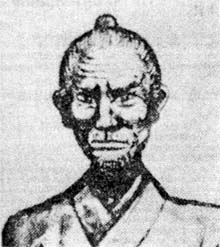Shuri-te
 Shuri-te founder Sokon Matsumura. | |
| Date founded | 1800s |
|---|---|
| Country of origin | |
| Founder | Sokon Matsumura |
| Arts taught | Karate |
| Descendant schools | Okinawa Shorin-ryu, Matsubayashi, Matsumura Seito, Shōbayashi, Seibukan, Zentokukai |
| Practitioners | Anko Itosu, Anko Asato, Choki Motobu, Chosin Chibana, Shoshin Nagamine, |
Karate orginated on Okinawa which is the largest island of the Ryukyu archipelago. It was a product of the ancient Okinawan culture. Okinawa Shorin-Ryu Karate is the oldest karate fighting style. Its founder, Sokon Matsumura - bodyguard chief of Ryukyu kingdom. Master Matsumura called his style Shuri-Te.
History
Shuri-Te is the name of the particular type of Okinawan martial art that developed in the Shuri, the ancient capital of Okinawa. One of the early Okinawan masters, To-De Sakugawa (1733-1815) is credited as being one of the initial importers of Chinese martial arts to Okinawa, in particular to Shuri, where he started the development of the Shuri-Te style of Okinawan martial arts.
Sokon Matsumura was a renowned warrior of his time; bodyguard to three kings of Okinawa, he has been called the Miyamoto Musashi of Okinawa and was dubbed bushi, or warrior, by his king. However, while he is often referred to as the "founder" of Shuri-te, he did not invent all the components of the style, and perhaps didn't refer to it as Shorin-ryu himself. It is quite possible that he synthesized his knowledge of Okinawan arts with Chinese fighting styles that he learned on his travels and taught it as a coherent system to some eager students, who subsequently refined it, labeled it, and passed it on. Shorin is the pronunciation of the Chinese Shaolin in Hogun ("Hogen" is standard Japanese for "dialect"; the suffix "-ben" is also used, but the modern use of the word "Hogen" is current Okinawan local "slang" for Uchinanchuguchi, TFA.) The primary dialect of Okinawa, although now an almost dead language due to the taking over of okinawa by Japan.; and ryu means "Association". Therefore, Shorin-ryu ("Shaolin association" or "small forest") reflects the Chinese influences intrinsic to the art.
Along with being a style on its own, Shorin-ryu is also perhaps the most influential single ancestor of modern Japanese karate. One of Matsumura's best-known students, Anko (or "Ankoh") Itosu became a great practitioner and teacher of Okinawan karate and developed the five Pinan kata, which are now taught not only in Shorin-ryu, but also in a wide variety of Okinawan, Japanese and derived martial arts. It is also believed by some that the first three Pinan kata were actually developed by Matsumura and the last two by Itosu. In addition, Itosu and another student of Matsumura's named Anko Azato were among the primary influences on a fellow Okinawan named Gichin Funakoshi. Funakoshi introduced his Okinawan martial arts to mainland Japan in 1922, and in subsequent decades was instrumental in developing what he termed simply karate or karate-do into a popular Japanese martial art. The style Funakoshi taught on mainland Japan is now called Shotokan karate.
